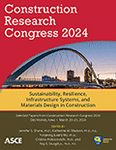Resilient Materials and Technologies for a Single-Family Home: A Review
Publication: Construction Research Congress 2024
ABSTRACT
Resilient materials and technologies (RMTs) can absorb external stresses imposed during a natural disaster and enhance a building’s resilience against natural disasters. Therefore, this study identifies RMTs available for implementation in a single-family home to be resilient against hurricanes and floods. The study also determined RMTs’ performance from the perspective of variables: multi-functionality, recyclability, smartness, and market maturity. The study used three-phased exploratory research involving establishing research parameters, data collection using the forward snowballing method, and then descriptive statistical analysis for the identified RMTs. The research identified 54 RMTs that could be adopted onto a single-family home’s substructure (17 RMTs) and shell (49 RMTs). A significant majority of the RMTs were mapped onto the homes’ shell assemblies. Further, most RMTs were identified as recyclable, and very few were as smart, thereby indicating the need for smart RMTs that can transform in response to external stresses.
Get full access to this article
View all available purchase options and get full access to this chapter.
REFERENCES
Amadeo, K. (2019). Hurricane Harvey Facts, Damage, and Costs What Made Harvey So Devastating. Also available at <https://www.lamar.edu/files/documents/resilience-recovery/grant/recovery-and-resiliency/hurric2.pdf>.
Aquinoa, D. H., Wilkinson, S., Raftery, G. M., and Potangaroa, R. (2019). Building back towards storm-resilient housing: Lessons from Fiji’s Cyclone Winston experience. International Journal of Disaster Risk Reduction, 33, 355–364.
Axios. (2022). “Hurricane Ian may have caused $67 billion in damage, a top 5 US storm.”.” <https://www.axios.com/2022/10/07/hurricane-ian-damage-estimate-costliest-storm-florida>, Last accessed (10/26/2022).
Berrang-Ford, L., Ford, J. D., and Paterson, J. (2011). Are we adapting to climate change? Global Environmental Change, 21(1), 25–33. https://doi.org/10.1016/j.gloenvcha.2010.09.012.
Bichard, E., and Kazmierczak, A. (2012). Are homeowners willing to adapt to and mitigate the effects of climate change? Climatic Change, 112(3–4), 633–654. https://doi.org/10.1007/s10584-011-0257-8.
CRS (Congressional Research Service). (2023). “Introduction to US Economy: Housing Market.” <https://crsreports.congress.gov/product/details?prodcode=IF11327>.
Das, S., and Mukhopadhyay, P. (2018). Multi-hazard disaster resilient housing with bamboo-based system. Using scientific knowledge to inform policy and practice in disaster risk reduction, 7th International Conference on Building Resilience, 27–29 November, Bangkok, Thailand.
DEFRA (Department for Environment, Food and Rural Affairs). (2008). Developing the evidence base for flood resistance and resilience: Summary Report (; p. 24). DEFRA.
Dong, Y., and Li, Y. (2016). Reliability of Roof Panels in Coastal Areas Considering Effects of Climate Change and Embedded Corrosion of Metal Fasteners. ASCE-ASME Journal of Risk and Uncertainty in Engineering Systems, Part A: Civil Engineering, 2(1), 04015016. https://doi.org/10.1061/AJRUA6.0000851.
FEMA. (2005). Hurricanes impact on Florida’s Florida’s building codes and standards: We have been given a wake up call. (; p. 23). FEMA.
FEMA. (2017). “Natural Hazards.” <https://hazards.fema.gov/nri/natural-hazards>, Last accessed (10/28/2022).
Fortified Housing. (2022). Fortified Housing. <https://fortifiedhome.org/>, Last accessed (12/20/2022).
González, C. M. (2020). Resilient Technologies Battling Climate Change. Mechanical Engineering, 142 (4), 36–41.
Guha-Sapir, D., Hoyois, P., Wallemacq, P., and Below, R. (2016). Annual Disaster Statistical Review 2016:The Numbers and Trends. (p. 91). CRED.
Hassler, U., and Kohler, N. (2014). Resilience in the built environment, Building Research & Information, 42 (2), 119–129. DOI: https://doi.org/10.1080/09613218.2014.873593.
Hoiling, C. S. (1973). Resilience and Stability of Ecological Systems. Annual Review of Ecology and Systematics, 4, 1–23. https://doi.org/10.1146/annurev.es.04.110173.000245.
Insurance Journal. (2018). “Nearly 670K Property Insurance Claims in Texas from Hurricane Harvey: TDI.” <https://www.insurancejournal.com/news/southcentral/2018/02/13/480405.htm>, Last accessed (10/26/2022).
Kreft, S., Eckstein, D., and Melchior, I. (2016). Who Suffers Most From Extreme Weather Events? Weather-related Loss Events in 2015 and 1996 to 2015 (p. 32).
Kunreuther, H. C., Wachter, S. M., Kousky, C., and LaCour-Little, M. (2019). Flood Risk and the US Housing Market. SSRN Electronic Journal. https://penniur.upenn.edu/uploads/media/Flood_Risk_and_the_US_Housing_Market.pdf.
Ladipo, O., Reichard, G., McCoy, A., Pearce, A., Knox, P., and Flint, M. (2019). Attributes and metrics for comparative quantification of disaster resilience across diverse performance mandates and standards of building. Journal of Building Engineering, 21, 446–454.
Meerow, S., Newell, J. P., and Stults, M. (2016). Defining urban resilience: A review. Landscape and Urban Planning, 147, 38–49. doi:https://doi.org/10.1016/j.landurbplan.2015.11.011.
Mora, C., et al. (2013). The projected timing of climate departure from recent variability. Nature, 502 (7470), 183–187. https://doi.org/10.1038/nature12540.
Mozumder, P., Chowdhury, A. G., Vásquez, W. F., and Flugman, E. (2015). Household Preferences for a Hurricane Mitigation Fund in Florida. Natural Hazards Review, 16(3), 04014031. https://doi.org/10.1061/(ASCE)NH.1527-6996.0000170.
NCDC-NCEI (National Centers for Environmental Information-National Centers for Environmental Information). (2019). Billion-Dollar Weather and Climate Disasters: Overview [Government]. https://www.ncdc.noaa.gov/billions/.
Saadat, S., Noori, M., Davoodi, H., Hou, Z., Suzuki, Y., and Masuda, A. (2001). Using NiTi SMA tendons for vibration control of coastal structures. Smart Materials and Structures, 10, 695.
Southwick, S. M., Bonanno, G. A., Masten, A. S., Panter-Brick, C., and Yehuda, R. (2014). Resilience definitions, theory, and challenges: interdisciplinary perspectives. European Journal of Psychotraumathology, 5. doi:https://doi.org/10.3402/ejpt.v5.25338.
Stapleton, S. O., Nadin, R., Watson, C., and Kellett, J. (2017). Climate change, migration and displacement (p. 36).
Weinstock, L. R. (2023). Introduction to US Economy: Housing Market.
Wohlin, C. (2014). Guidelines for snowballing in systematic literature studies and a replication in software engineering. Proceedings of the 18th International Conference on Evaluation and Assessment in Software Engineering, Sweden.
Zhao, D., McCoy, A. P., and Smoke, J. (2015). Resilient Built Environment: New Framework for Assessing the Residential Construction Market. Journal of Architectural Engineering, 21(4). https://doi.org/10.1061/(ASCE)AE.1943-5568.0000177.
Information & Authors
Information
Published In
History
Published online: Mar 18, 2024
Authors
Metrics & Citations
Metrics
Citations
Download citation
If you have the appropriate software installed, you can download article citation data to the citation manager of your choice. Simply select your manager software from the list below and click Download.
